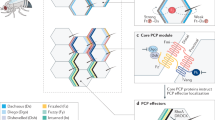Abstract
Morphogenesis involves coordinated proliferation, differentiation and spatial distribution of cells. We show that lengthening of renal tubules is associated with mitotic orientation of cells along the tubule axis, demonstrating intrinsic planar cell polarization, and we demonstrate that mitotic orientations are significantly distorted in rodent polycystic kidney models. These results suggest that oriented cell division dictates the maintenance of constant tubule diameter during tubular lengthening and that defects in this process trigger renal tubular enlargement and cyst formation.
This is a preview of subscription content, access via your institution
Access options
Subscribe to this journal
Receive 12 print issues and online access
$209.00 per year
only $17.42 per issue
Buy this article
- Purchase on Springer Link
- Instant access to full article PDF
Prices may be subject to local taxes which are calculated during checkout


Similar content being viewed by others
References
Gong, Y., Mo, C. & Fraser, S.E. Nature 430, 689–693 (2004).
Ahringer, J. Curr. Opin. Cell Biol. 15, 73–81 (2003).
Mateescu, B., England, P., Halgand, F., Yaniv, M. & Muchardt, C. EMBO Rep. 5, 490–496 (2004).
Soriano, P. Nat. Genet. 21, 70–71 (1999).
Vooijs, M., Jonkers, J. & Berns, A. EMBO Rep. 2, 292–297 (2001).
Jung, A.C., Denholm, B., Skaer, H. & Affolter, M. J. Am. Soc. Nephrol. 16, 322–328 (2005).
Wilson, P.D. N. Engl. J. Med. 350, 151–164 (2004).
Boletta, A. & Germino, G.G. Trends Cell Biol. 13, 484–492 (2003).
Gresh, L. et al. EMBO J. 23, 1657–1668 (2004).
Ward, C.J. et al. Nat. Genet. 30, 259–269 (2002).
Lager, D.J., Qian, Q., Bengal, R.J., Ishibashi, M. & Torres, V.E. Kidney Int. 59, 126–136 (2001).
Gattone, V.H., II et al. Lab. Invest. 59, 231–238 (1988).
Pazour, G.J. J. Am. Soc. Nephrol. 15, 2528–2536 (2004).
Simons, M. et al. Nat. Genet. 37, 537–543 (2005).
Germino, G.G. Nat. Genet. 37, 455–457 (2005).
Acknowledgements
We are grateful to B. Mateescu for the H3pS10 antibody and to A. Blanchard for the aqp2 antibody. We thank E. Perret, P. Roux and M. Delarue for assistance and advice, and F. Terzi and J. Weitzman for helpful discussions and for critical reading of the manuscript. E.F. is a fellow of the Association pour l'Information et la Recherche sur les maladies Rénales Génétiques (AIRG). This work was supported by the PKD Foundation, Genzyme Corporation and La Ligue contre le Cancer, as well as by grants (to E.L. and J.F.N.) from Cells into Organs (EU Framework 6 project LSHM-CT2003-504468), EurostemCell (EU Framework 6 project LHSB-CT2003-503005) and the Association Française contre les Myopathies (AFM).
Author information
Authors and Affiliations
Ethics declarations
Competing interests
The authors declare no competing financial interests.
Supplementary information
Supplementary Fig. 1
Tubular cell proliferation in newborn mice. (PDF 708 kb)
Supplementary Fig. 2
Tubular luminal diameter in precystic pck rats. (PDF 66 kb)
Supplementary Fig. 3
Onset of mitotic distortion precedes tubular dilation in mutant mice. (PDF 147 kb)
Rights and permissions
About this article
Cite this article
Fischer, E., Legue, E., Doyen, A. et al. Defective planar cell polarity in polycystic kidney disease. Nat Genet 38, 21–23 (2006). https://doi.org/10.1038/ng1701
Received:
Accepted:
Published:
Issue Date:
DOI: https://doi.org/10.1038/ng1701
This article is cited by
-
Mechanism of cystogenesis by Cd79a-driven, conditional mTOR activation in developing mouse nephrons
Scientific Reports (2023)
-
Nephronophthisis: a pathological and genetic perspective
Pediatric Nephrology (2023)
-
Elevated level of lysophosphatidic acid among patients with HNF1B mutations and its role in RCAD syndrome: a multiomic study
Metabolomics (2022)
-
Mechanisms of ion transport regulation by HNF1β in the kidney: beyond transcriptional regulation of channels and transporters
Pflügers Archiv - European Journal of Physiology (2022)
-
Spindle positioning and its impact on vertebrate tissue architecture and cell fate
Nature Reviews Molecular Cell Biology (2021)



